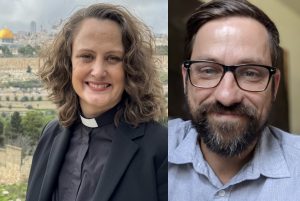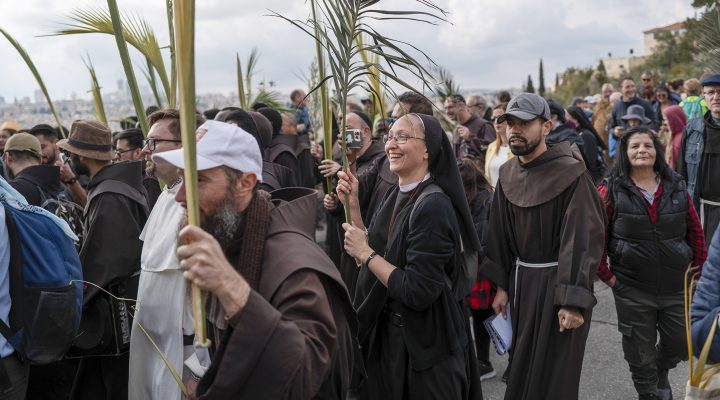While all eyes are on Gaza, Israel’s occupation policies continue to quietly erase the presence and identity of ancient Christian communities of the Holy Land.
Israeli policies limit the ability of Palestinians in the occupied West Bank to access ancient holy sites in Jerusalem that represent the foundation of Christian religious traditions. The cruelty of these Israeli policies exacerbates the suffering of an already traumatized community, many of whom have lost family in Gaza, where more than 32,000 people including at least 13,000 children have been killed.
Saturday a week ago, predominantly local Christians from Jerusalem and Israel gathered for their annual Palm Sunday festival to retrace Jesus’ triumphal entry into Jerusalem. It is an annual ritual for the Christians of the Holy Land, usually joined by masses of pilgrims from around the world. They gather on the Mount of Olives, in years past 15,000 people or more, bearing giant palm branches and process across the Kidron Valley into the Old City of Jerusalem.

Mae Elise Cannon and Ben Norquist
This year’s observance was not the same in size or tone. How could it be while these Christians are coping with the widespread loss of their families in Gaza? West Bank Palestinians have described today’s realities as worse than those suffered during the Second Intifada.
Indeed, signs could be seen in the crowds calling attention to the atrocities. One sign, in particular, highlighted the plight of Gaza’s tiny Christian community of less than 1,000, which, as a global group of Christian leaders recently warned the White House, is threatened with complete annihilation if the war continues — nothing less than a genocide, many are saying.
A group of Palestinian Christians, in partnership with international organizations, led a movement called “Holy Week with Gaza” to draw attention to the devastations of the moment. One of these leaders, Mitri Raheb, captured the hell Palestinian Christians feel: “We bear witness to horrors never even imagined in our ancient Christian community in Gaza, and with it, thousands of years of Palestinian culture and heritage disintegrate before our own eyes.”
The number of participants was way down this year. Richard Sewell, dean of St. George’s College in Jerusalem, was there on the Mount of Olives; he estimates there were only around 5,000 attendees, a small fraction of the usual number. The Christian Information Center, a group that tracks the pilgrimage, said there were only 40 pilgrimage groups during Holy Week this year, down from an average of 500 in the past.
The low numbers and shadow of war were felt deeply. In his plenary remarks, the Latin patriarch of Jerusalem, Cardinal Pierbattista Pizzaballa, said, “We are here again, even if few in number, without pilgrims and without so many of our brothers and sisters.”
Who was absent? Palestinians from the occupied Palestinian territories and international pilgrims.
Villages with a Christian presence in the West Bank usually try to send groups to Jerusalem for the procession. This year, Israeli occupation authorities denied the vast majority of these communities permission to join. As always, the church applied for about 20,000 permits for its parish members. Virtually all were denied. Of the handful of permits that were approved, it was so late that they functioned as a denial — there was no time to make travel arrangements. Many internationals also were not present because people did not feel comfortable traveling during the war, and airlines have significantly reduced the available flights.
“These crimes of Hamas in no way justify the tens of thousands of deaths of civilians in Gaza and the brutal treatment of Palestinians in other parts of the occupied territories.”
Participants on Palm Sunday noticed a significant police presence along the whole processional path, often with military-grade weapons drawn. It put a disconcerting damper on the tone of festivities as the police, known locally for the mistreatment of Palestinians, strode through the crowds.
Israel also has increased the number of checkpoints inside the West Bank in recent months and piled up mountains of rubble at the entrance roads to Palestinian villages. As a result, countless families can’t even travel to the next town over to celebrate with family and friends, let alone travel to Jerusalem. The danger of encountering violent settlers or being harassed at a checkpoint is too high.
We have consistently condemned the horrific actions Hamas committed, causing the deaths of 1,200 individuals and more than 200 people being taken captive in Gaza. These crimes of Hamas in no way justify the tens of thousands of deaths of civilians in Gaza and the brutal treatment of Palestinians in other parts of the occupied territories.
Unfortunately, the present Israeli government is the most stridently pro-occupation and pro-settler in history — the government just announced the largest seizure of Palestinian land, almost 4 square miles, since 1993. It should be no surprise their track record on freedom of worship for Palestinian Christians is shambolic, but the stakes are high, because as Christian culture is undermined and land stolen, Christians flee the region and the church gets weaker and smaller in the land where it began.
The holy season is only beginning for Christians. As the Western church observed Holy week, Lent in the Eastern calendar was just starting. The annual evangelical worship service normally held at the Garden Tomb was canceled due to a lack of permits for Palestinians to travel to Jerusalem.
What will the Holy Land look like if one day it is a place empty of Christianity in the very place where Christianity began?
Mae Elise Cannon is executive director of Churches for Middle East Peace, and Ben Norquist is the Ambassador Warren Clark Fellow for CMEP.


